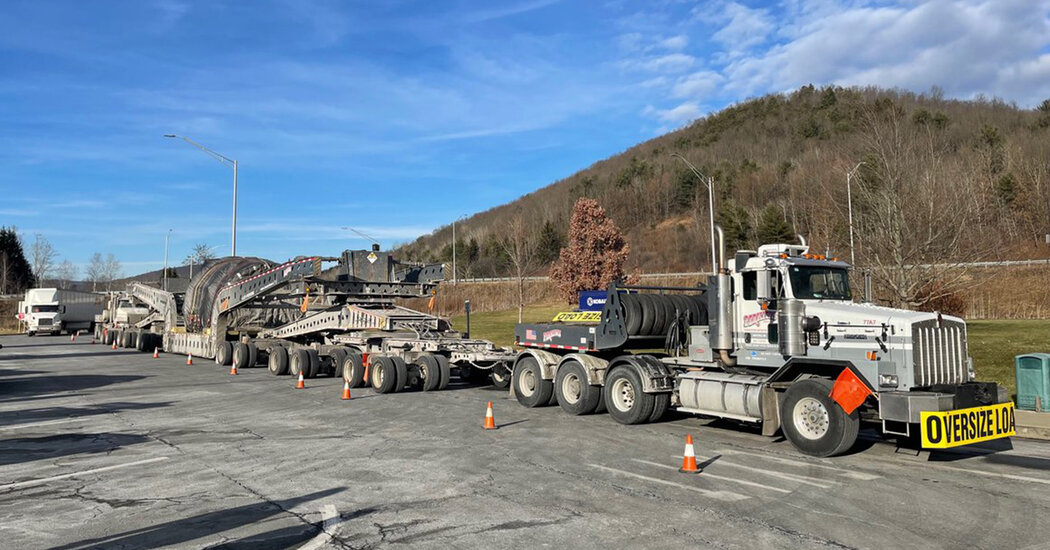A mammoth tractor-trailer is hauling a tank from a decommissioned nuclear training site for disassembly near Pittsburgh. Top speed: 30 m.p.h.
It is called a superload, and for good reason: The highway behemoth is longer than five fire trucks and weighs as much as two blue whales.
This week and next week, the mammoth tractor-trailer, hauling a tank from a decommissioned nuclear training site, will lumber across Pennsylvania on a 400-mile route that would test the skills of even the most seasoned trucker.
The metal leviathan, which takes up two lanes of traffic, measures 213 feet from end to end and weighs 294 tons, putting merely oversize loads to shame.
As it rolls across the state on what is expected to be a nine-day journey, the rig with several flatbeds and escort vehicles must cross 16 counties, navigating exit ramps, country roads, two-lane highways, unusual traffic patterns and a potential snowstorm.
The truck can travel only at the posted speed limit or 30 miles per hour, whichever is lower, according to the Pennsylvania Department of Transportation.
Unsurprisingly, drivers should expect delays if they find themselves caught behind the superload, although it is expected to travel mostly at night to cut down on bottlenecks, the department said.
Lew Grill, a truck-driving expert and instructor in Montana with 54 years’ experience on the road, said he had deep respect for any truck driver who could haul a 294-ton load.
He said the weight limit for the average tractor-trailer is 40 tons, featherweight by comparison.
“This is phenomenal,” Mr. Grill said. “If this guy pulls this off professionally, he should get accolades. We should bow to him. There are not many drivers like this.”
Mr. Grill said the driver will need to respond to unforeseen challenges, like cars stopped on the side of the road.
The escort drivers are “only the extra eyes and ears of the captain of the ship,” he said. Ultimately, the truck driver is responsible for ensuring that the superload reaches its destination safely, he said.
Although the tank is empty, it is radioactive because of its proximity to the D1G Prototype reactor, which had been used at the Kenneth A. Kesselring Site in West Milton, N.Y., near Saratoga Springs, to train Navy sailors on the operation of propulsion systems in the Navy’s nuclear-powered fleet.
The prototype reactor was decommissioned in 1996, and the reactor’s fuel was removed in 1997, according to the Naval Nuclear Laboratory. The tank, which was part of a system used to support the prototype reactor, contains no residual fuel, according to Saralynne DelRaso, a laboratory spokeswoman.
She said that a person who was close to the outside of the tank for one hour would receive less radiation exposure than a passenger might receive on a cross-country flight from New York to Seattle.
Ms. DelRaso said that the company that was transporting the tank planned to have three escort vehicles and three State Police vehicles accompany the truck.
Since the trailer is wide, drivers may not pass on two-lane roads until the rig pulls to a stop and the escorts allow traffic to go by, she said.
The shipment required numerous permits, all of which included advance notice of the operation as well as approval of the proposed route and timing, Ms. DelRaso said.
The truck left the Kesselring Site on Jan. 5, and crossed into northeast Pennsylvania on Wednesday night, she said.
It was expected to reach Wampum, Pa., about 41 miles north of Pittsburgh, on Jan. 21. The tank will then be disassembled, with some of it recycled and the rest discarded.
A winter storm that is forecast to hit the Northeast over the weekend could complicate the journey. The National Weather Service has warned of hazardous road conditions, with early estimates of four inches of snow or more in parts of Pennsylvania.
Perkins Specialized Transportation Contracting, a heavy-haul and superload logistics company in Becker, Minn., which was transporting the tank, declined to comment on the undertaking on Thursday.
But the job is not the biggest the company has completed.
In the summer of 2018, it hauled seven engines weighing 318 tons each on a 61-mile route from a port in the Upper Peninsula of Michigan, according to the company’s website. The shipment took more than a year and a half to plan and three and a half weeks to complete and required route surveys, feasibility studies and outside support teams.
The Pennsylvania Department of Transportation was urging people to track the superload on social media with the hashtag #PAsuperload22.
“It’s going to be team effort, with troopers from at least six different stations taking part at various intervals,” Lt. Adam Reed, a State Police spokesman, said. “Safety and security will be our top priorities, and we ask for patience as we ensure it safely gets to its destination.”































